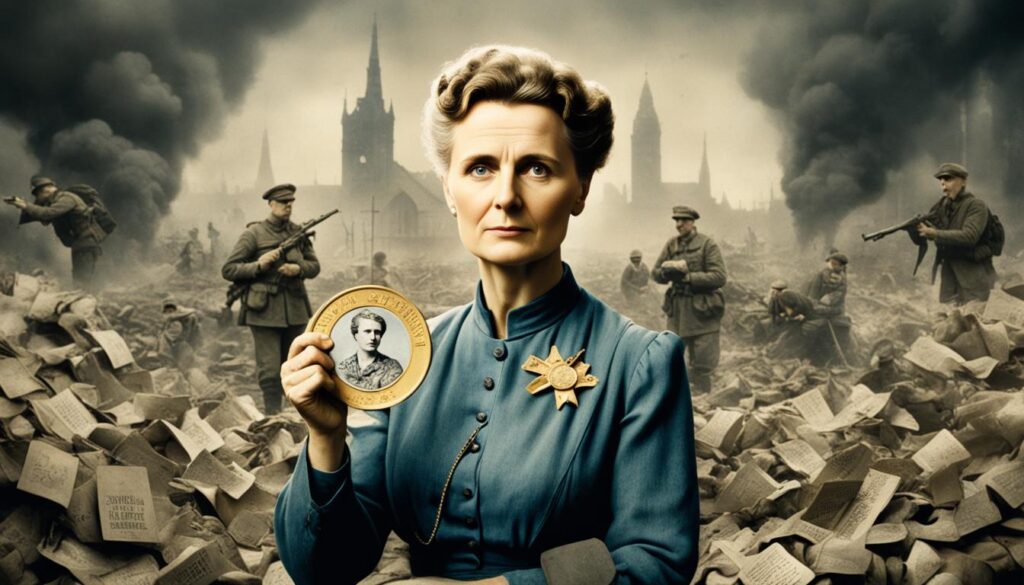Marie Curie was a brilliant scientist known for her work on radioactivity. She was born in Warsaw in 1867. Her work went far beyond her discoveries. She was the first woman to win a Nobel Prize and the only one to win in two fields.
When World War I hit Europe, Curie showed her true colors. She offered her Nobel Prize medals to help France. Even when the government said no, she didn’t give up. She put most of her Nobel money into war bonds to help the country.
Key Takeaways
- Marie Curie offered her Nobel Prize medals to support France in World War I
- She invested her Nobel Prize money in war bonds
- Curie established France’s first military radiology centers
- She trained women in X-ray technology for the war effort
- Curie’s scientific legacy extended beyond her radioactivity research
- She was the first woman to win a Nobel Prize and the only person with two in different fields
Marie Curie’s Scientific Legacy and Nobel Prizes
Marie Curie was a trailblazer for women in science. She discovered two new elements: polonium and radium. Her work changed how we understand radioactivity, a term she named.
In 1903, Curie won her first Nobel Prize in Physics. She shared it with her husband Pierre Curie and Henri Becquerel for their work on radioactivity. This made her the first woman to win a Nobel Prize.
Curie didn’t stop there. In 1911, she won another Nobel Prize, this time in Chemistry. This prize was for her discovery of radium and polonium, and her work on radioactivity.
Her impact went beyond the lab. Curie became the first woman professor at the Sorbonne University in Paris. She also started the Radium Institute, a leading center for radioactivity research.
Marie Curie’s legacy still motivates scientists today. Her discoveries have led to many advances in physics and chemistry. She is a strong example of what women can achieve in science.
Curie’s Nobel Prize Donation and WWI Contributions

Marie Curie donated her Nobel Prize to help during World War I. She gave her two medals to the French government for the war. Even though they were declined, her act showed her deep commitment to charity.
She then put most of her Nobel Prize money into war bonds. This helped the nation financially. Curie’s actions showed her dedication to the cause.
Curie did more than just give money. She started a military radiotherapy service. She collected radon gas and put it in glass tubes for medical use. Despite the risks, she worked hard to help others.
Her work showed her commitment to making a difference. She set up 20 mobile X-ray stations and 200 stationary units in France. These units helped diagnose and treat soldiers.
By 1916, Curie trained women as radiological assistants at the Radium Institute. This move increased the reach of radiology and gave women a chance to help in the war.
The Petites Curies: Mobile X-Ray Units on the Battlefield
Marie Curie’s innovative spirit led to a groundbreaking development in World War I technology. She and her daughter Irène created mobile X-ray units. These units were called “Petites Curies” by French soldiers.
These units changed battlefield medicine by bringing radiological equipment right to the frontlines. They were a game-changer.
Curie worked hard to get vehicles from wealthy friends. She turned them into mobile X-ray units with portable electric generators. By October 1914, the first 20 Petites Curies were ready to help.
Marie Curie didn’t just lead the project. She got hands-on, learning to use the X-ray machines, studying anatomy, and even driving and fixing the vehicles. She used these units near combat, helping wounded soldiers.
This work saved many lives during World War I. It also set the stage for future advances in emergency care. The Petites Curies show Marie Curie’s commitment to science and helping others.
Marie Curie’s Lasting Impact on Science and Society
Marie Curie changed the game in physics and chemistry. Her work on radiation started a new era in science. Her discoveries helped create new medical technologies, like X-ray imaging and cancer treatments.
Curie was a role model for women in science. Her daughter, Irène Joliot-Curie, also made big discoveries in radioactivity. The Curie family’s work encourages scientists everywhere to push past gender limits in STEM fields.
The Marie Curie charity honors her legacy. It supports research in palliative and end-of-life care in the UK. This charity shows Curie’s drive to make life better through science. Even though she died in 1934 from radiation, her impact on science and society is still huge.

Leave a Reply